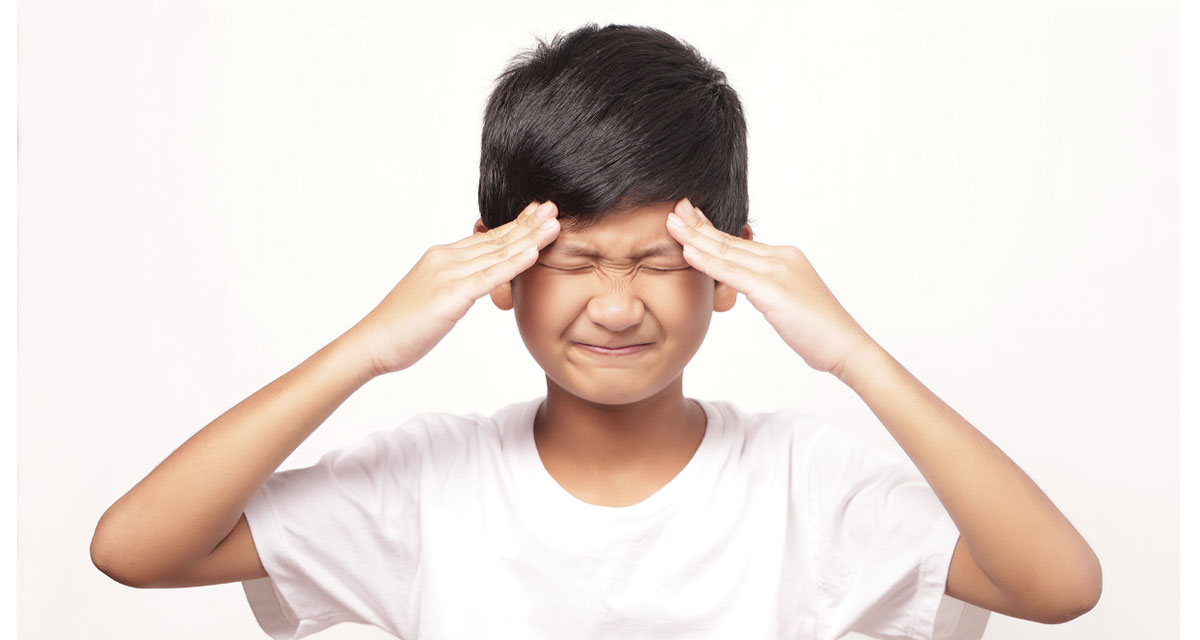“Mommy, my head hurts!”
As a parent, you know how hard it is to hear those words, knowing your child is in pain. What’s even harder is not knowing what’s causing their pain or how to help them feel better. If your child’s head pain episodes are frequent, do you wonder, “Could this be migraine?”…and then dismiss the idea because only adults have migraine, right? The truth is, even infants and young children can have migraine. In fact, by age 10, one in 20 kids has migraine. Could your son or daughter be one of them?
Finding the answer may require some detective work. Migraine can look different in children than in adults, so here are some key questions to ask:
- Do you or the child’s other parent have migraine? Do other relatives have it? Family history is important because migraine is an inherited disease. If one parent has migraine, a child has a 50% chance of having it, too. If both parents have migraine, their child has a 75% chance of inheriting migraine disease.
- Was your child a colicky baby? According to research, colicky babies are more likely to have childhood migraine.
- Does your elementary-age child have recurring stomach aches that last a long time?
These may be episodes of abdominal migraine, often an indication that the child will develop migraine in the future. - If your child is too young to tell you how they feel, observe their behavior when in pain. Do they want to be in a dark, quiet room? They may be sensitive to light and/or sound, common features of migraine. Do they have decreased appetite? They may be experiencing nausea, also common with migraine.
- For older children, Dr. Lauren Strauss, a pediatric headache specialist at Atrium Health Wake Forest Baptist, recommends gently asking questions during their migraine attack (because they often don’t remember details the next day):
“Where does it hurt in your head? Show me with your hands.”
“Do you want to listen to music, or do you prefer quiet?”
“Does your tummy hurt?”
If the answers suggest migraine, keep a log of your observations and conversations with your child. Tracking your child’s experience provides a vital piece of the puzzle, because there’s no blood test, scan, or any other test for diagnosing migraine. Doctors must rely on family history, parental observations, and conversations with the child to determine if he or she has migraine.
If you suspect your child has migraine, share your family history and your observation log with your child’s doctor or a pediatric headache specialist. If migraine is diagnosed, partner with the doctor on a plan of action. Treatment may include recommendations for lifestyle changes, supplements such as vitamin B2, magnesium, coenzyme q10, and medicines to relieve or prevent attacks.
How to Help Your Child
There are many practical and loving ways to help your child deal with migraine. Here are three things parents can provide:
- Reassurance. While others may dismiss your child’s migraine complaints, you can provide reassurance and empathy. A child who hears mom or dad say, “I believe you,” knows they’re not alone on their migraine journey. Parents can also assure their child that a migraine attack isn’t dangerous, and that the pain will pass.
- Lifestyle. Super-sensitive migraine brains crave consistency. Kids should not skip meals, especially breakfast. They need 8-10 hours of nightly sleep and a consistent bedtime, even on weekends. It’s also important to stay hydrated, avoid caffeine, and get exercise. A “migraine-friendly” lifestyle can be difficult for busy families with sports and church activities that can last till 9:00 at night. Dr. Strauss encourages parents to see their child’s headaches as a warning that it’s time to rethink the family’s schedule and priorities.
- Comfort. Dr. Strauss encourages parents to create a “headache cave” for their child, a comforting place to retreat during a migraine attack. The “cave” can be any quiet room where lights are off and, if the child is not sensitive to fragrance, essential oils such as lavender can be used to create a soothing aroma. Discovering what’s most helpful can be a trial-and-error process, but parents will eventually be able to prepare a kit ahead of time that includes whatever helps the child get through the headache. For example, a “headache cave kit” could include: migraine medicine, sleep mask, ear plugs or headphones, anti-nausea bands, throw up bag, ice pack or warm pack, and a weighted blanket. Some children are also especially comforted by the presence of a pet such as a bunny or cat that serves as a “therapy animal” during the headache.
To learn more about pediatric migraine, visit AmericanMigraineFoundation.org



















